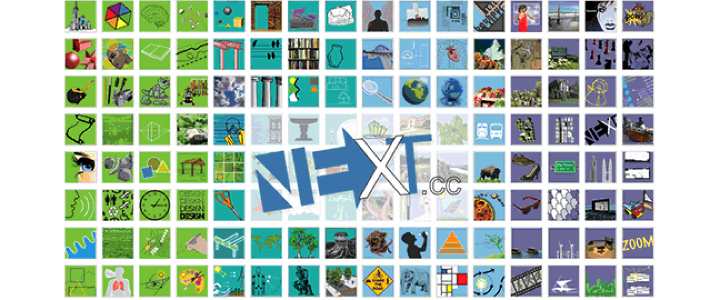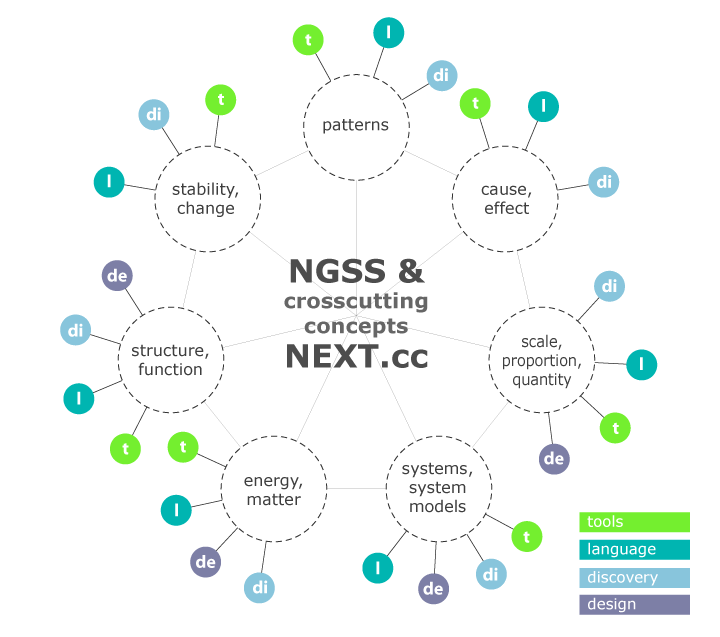NGSS Crosscutting Concepts & NEXT.cc
Fostering Innovative Thinking With Arts Integration and NGSS Crosscutting Concepts
“Through art, we recognize that which we know to be important and true; through art,
we encounter that which is not yet known, yet hovers on the edges of consciousness.
Through art and theory, we form new patterns of perception that enable us to see the
world with fresh insight.” Olivia Gude
From the National Governors Association’s New Engines of Growth report to the 2014 Global Innovation Index, there’s growing evidence that arts integration works!(1) New trans-disciplinary arts initiatives, backed by multi-million dollar Federal budgets, demonstrate that the arts can strengthen STEM skills and spark creativity in the 21st-century American workforce.
With new allies from business and civic sectors, art and design education is playing an increasingly important role in the nation’s economic agenda, including the President’s Educate to Innovate and Turnaround Arts initiatives. Globally as well as nationally, thought leaders recognize that, “In today’s world, innovation is a subject of great importance because it stimulates sustainable growth in a highly competitive market.”(2) The expanded role of the arts brings art and design education into alignment with the trans-disciplinary focus of the Next Generation Science Standards (NGSS), particularly the new Engineering, Technology and Applications of Science standards, and fosters new communities of practice, including the eLearning Designopedia, NEXT.cc!
Robert Root-Bernstein, creativity researcher and Professor of Physiology at Michigan State University, observes that “A consensus is emerging that scientists and engineers need skills associated with, and often learned from, the arts.(3)
These skills include the abilities:
• to observe acutely
• to think spatially (what does an object look like when I rotate it in my mind?) and kinesthetically (how does it move?)
• to identify the essential components of a complex whole
• to recognize and invent patterns (the “rules” governing a system)
• to gain what the Nobel-Prize winner Barbara McClintock called ‘a feeling for the organism’ - empathy with the objects of study, [a key tenet in design learning], and
• to synthesize and communicate the results of one’s thinking visually, verbally, or mathematically.
The close correspondence of these skills with the NGSS Crosscutting Concepts suggests new opportunities for promoting innovative thinking through trans-disciplinary learning and arts/science integration. The crosscutting concepts – seven in all, including patterns; cause and effect; scale proportion, and quantity; systems and systems models; energy and matter; structure and function; and stability and change – are described as “ideas that transcend disciplinary boundaries and prove fruitful in explanation, in theory, in observation, and in design.” They are “powerful ideas…[which] are not the intellectual property of any one field or discipline.”(4) At Next.cc, an eLearning Designopedia, the Crosscutting Concepts from the NGSS appear as topics of learning Journeys, as activities within the Journeys, and as Explore links to outside resources. As teachers strive to unite the three dimensions of the NGSS framework, i.e, the Science and Engineering Practices, Disciplinary Core Ideas, and Crosscutting Concepts, within Performance Expectations, the resources at NEXT.cc offer unique perspectives on many of the crosscutting concepts and suggest ways to integrate art and design experiences within science instruction and connect real world practices.
NEXT.cc’s learning Journeys include science as well as art and design-based experiences. Many science-based resources correspond directly with the application of crosscutting concepts suggested in the Standards. For example, a fifth grade Performance Expectation (PE) requires students to “Develop a model to describe the movement of matter among plants, animals, decomposers, and the environment.” The PE encompasses an understanding of the crosscutting concepts, Energy and Matter as well as a Systems view of the movement of energy and matter in organisms. At NEXT.cc’s Plant Journey, learners find science activities directly related to the performance expectation, including an activity in which students diagram the process of photosynthesis, and a link to an ITSI lesson on the Decomposition of Plants. At the Food Journey, learners gain a deeper appreciation for systems thinking as they play the Nutrients for Life: Feed the World Game, or create food chain simulations with Insightmaker©.

The Journeys at NEXT.cc’s Designopedia also offer innovative opportunities for students to master NGSS performance expectations, while creating art. As first grade students “Plan and conduct investigations to provide evidence that vibrating materials can make sound and that sound can make materials vibrate,” they must also gain understanding of Cause and Effect relationships. At our Sound Journey, students can visit the San Francisco Exploratorium to learn how to make Experimental Instruments, or follow a link to Interactive Sound Activities which allow them to experiment with the effects of shortening or lengthening a virtual guitar string.
With these and many more resources culled from over 250 learning Journeys and 10,000+ Explore links, NEXT.cc offers teachers and learners place-based, project-based, and digital learning experiences that cross disciplinary boundaries and support innovative thinking in the arts and science. As you’ll find in our science section, the Learning Journeys and Explore links at NEXT.cc are also aligned with NGSS disciplinary core ideas from each of the four disciplines – life science; physical science; earth and space science; and engineering, technology, and the applications of science. NEXT.cc K-2, 3-5, and 6-8.
In our coming blog posts, we will continue the discussion of the crosscutting concepts and their integration in art/design/science instruction. So, please, return soon. In the meantime, we invite you to sharpen your digital literacy skills by contributing to our learning Journeys and Gallery where students and teachers, alike, can post work.
1 New Engines of Growth: Five Roles for Arts, Culture, and Design. National Governors Association. Prepared by Erin Sparks and Mary Jo Waits at the NGA Center for Best Practices, in collaboration with Bill Fulton of Solomar Research Group, May 2012.
2 The Global Innovation Index 2014: The Human Factor in Innovation. Soumitra Dutta, Bruno Lanvin, and Sacha Wunsch-Vincent, Editors. Published by Cornell University, INSEAD, and the World Intellectual Property Organization (WIPO, an agency of the United Nations, UN).
3 The Global Innovation Index 2014 Edition: The Human factor in Innovation.
4 Robert Root-Bernstein. The Arts’ Unsung Role in Supporting Science.
Copyright Prakken Publications, Inc. Dec 1997
5 Benchmarks Online. Chapter 11. Common Themes.
Curriculum and Instruction, University of Chicago Michigan Professional Education Certification Elementary K-8 All Subjects, Art Education (LX) K-12 STEM to STEAM and Design Learning Program Consultant and Grant Writer




















































